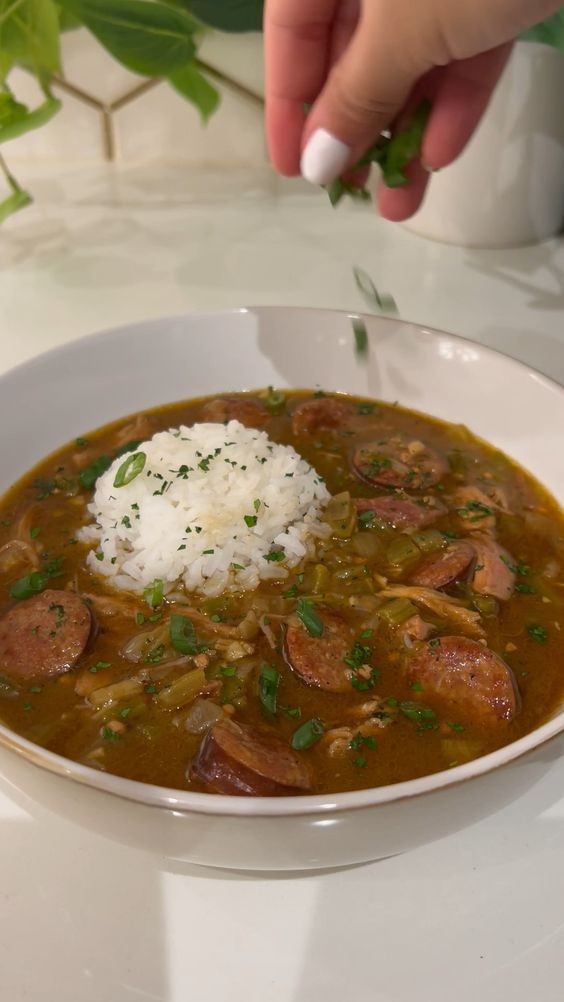The Savory Delight of Chicken and Sausage Gumbo: A Culinary Exploration
Chicken and sausage gumbo, a hallmark of Louisiana cuisine, stands as a testament to the rich cultural tapestry and culinary ingenuity of the region. This hearty, flavorful dish embodies the essence of Southern comfort food, blending diverse ingredients and cooking traditions into a harmonious and satisfying meal.
Origins and History
Gumbo’s roots are a complex interweaving of various cultural influences, reflective of Louisiana’s melting pot heritage. The dish itself has elements from French, Spanish, African, and Native American cuisines. The name "gumbo" is derived from the West African word for okra, "ki ngombo," as okra was traditionally used as a thickening agent in the stew.
Historically, gumbo was a dish that evolved from the need to make do with what was available. It was a versatile meal that could accommodate various ingredients, making it an ideal choice for a community with diverse food sources. Over time, gumbo became a staple at social gatherings, celebrations, and family dinners, symbolizing hospitality and togetherness.
Ingredients and Preparation
Chicken and sausage gumbo is renowned for its deep, rich flavors, achieved through a careful balance of ingredients and cooking techniques. Here’s a closer look at what goes into this beloved dish:
Key Ingredients
Chicken: Typically, bone-in chicken pieces are used for their robust flavor. The chicken is often browned to develop a deeper taste before being simmered in the gumbo.
Sausage: Andouille sausage is the traditional choice, known for its smoky, spicy profile that enhances the overall flavor of the gumbo.
The Holy Trinity: A foundational component of many Creole and Cajun dishes, the "holy trinity" consists of onions, bell peppers, and celery. These vegetables provide a flavorful base for the gumbo.
Roux: A critical element in gumbo, roux is a mixture of flour and fat (usually oil or butter) cooked until it reaches a deep brown color. This process imparts a nutty flavor and acts as a thickening agent.
Broth: Chicken broth serves as the liquid base, enriched by the flavors of the meat and vegetables.
Okra or Filé Powder: Traditionally, okra is used to thicken the gumbo, though filé powder (ground sassafras leaves) is also common, especially when okra is out of season.
Seasonings: Creole seasoning blends, bay leaves, thyme, and garlic are typical, infusing the gumbo with a distinctive Southern zest.
Preparation
The process of making chicken and sausage gumbo is as much an art as it is a science. Here’s a step-by-step guide to crafting this culinary masterpiece:
Prepare the Roux: The roux is made by whisking flour into hot oil or butter and cooking it over low to medium heat. Stir constantly until it reaches a deep, rich brown color, being careful not to burn it.
Cook the Holy Trinity: Once the roux is ready, add the chopped onions, bell peppers, and celery. Sauté until the vegetables are soft and fragrant.
Brown the Meats: In a separate pan, brown the chicken and sausage. This step enhances the flavors through caramelization.
Combine and Simmer: Add the browned meats to the roux and vegetable mixture. Pour in the chicken broth and add seasonings. Bring to a boil, then reduce to a simmer. Let the gumbo cook slowly, allowing the flavors to meld. This can take anywhere from 45 minutes to several hours.
Thicken and Serve: Add okra or filé powder towards the end of the cooking process. Serve the gumbo over steamed rice, garnished with chopped green onions or parsley.
Cultural Significance
Chicken and sausage gumbo is more than just a dish; it’s a cultural icon. It represents the fusion of different culinary traditions and the resourcefulness of the people who created it. Gumbo is often associated with family gatherings and communal meals, embodying the spirit of Southern hospitality and community.
In Louisiana, gumbo competitions and festivals are common, celebrating this beloved dish and its variations. Each family and chef often has their own secret recipe, passed down through generations, adding to the rich tapestry of gumbo lore.
Conclusion
Chicken and sausage gumbo is a dish that tells a story – of history, culture, and culinary creativity. Its rich, layered flavors and comforting warmth make it a favorite among those who appreciate the depth and soul of Southern cooking. Whether enjoyed at a bustling festival or a quiet family dinner, gumbo remains a cherished symbol of Louisiana’s vibrant culinary heritage.






